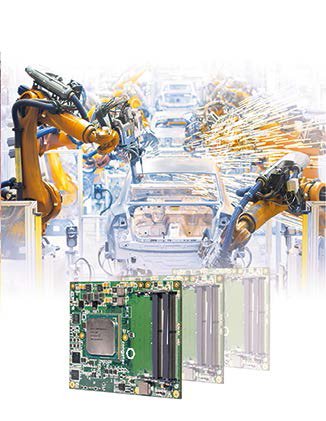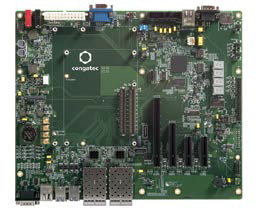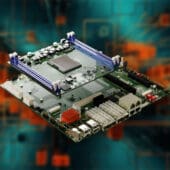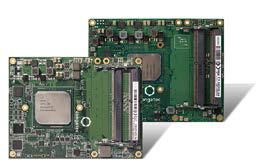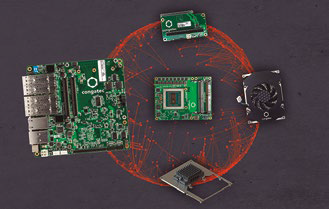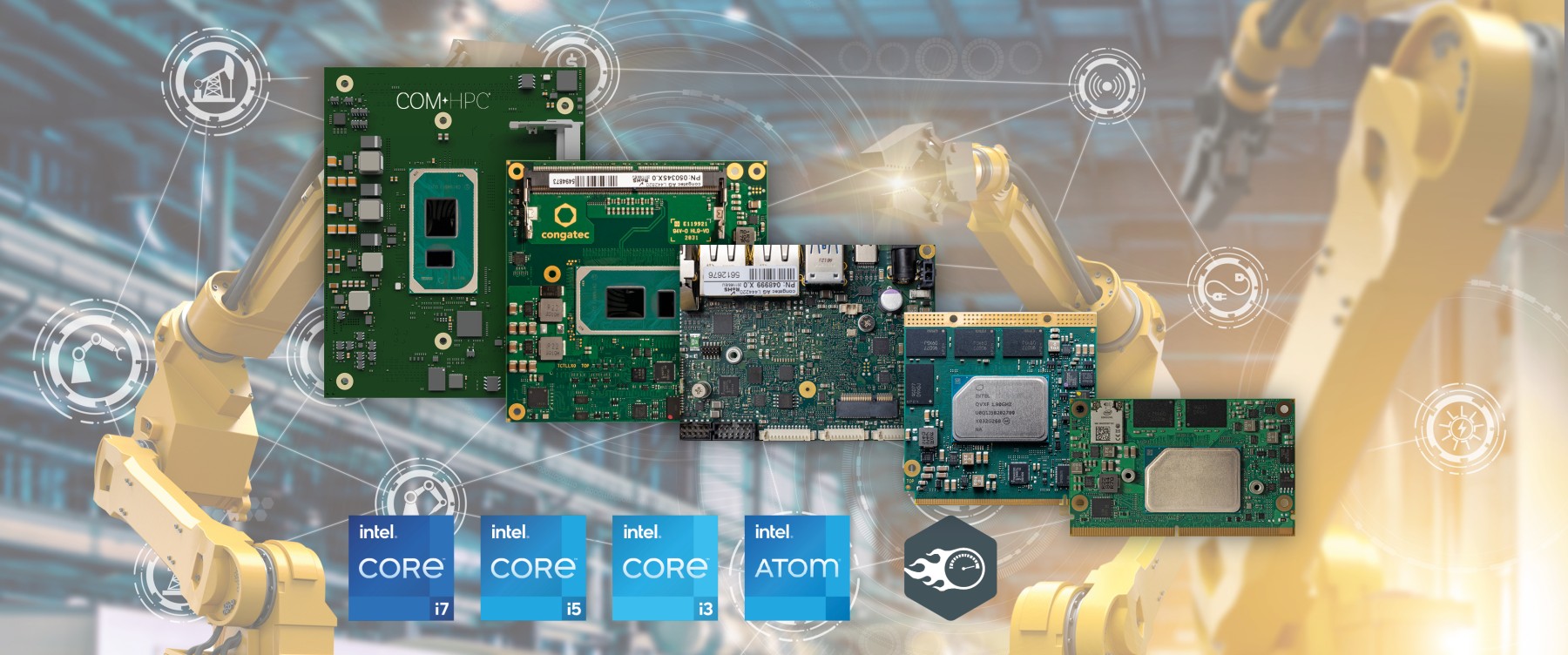Many future networking applications demand massive bandwidths and real-time data communication in a small form factor edge server design with dedicated field interfaces. COM-Express type 7 server modules are the right platforms for designing such dedicated micro servers for edge locations.
With many customers today supporting 1GbE connectivity and the global availability of gigabit bandwidths for these devices over public wired and wireless infrastructures, there are more and more new applications that require full-bandwidth communication capabilities with up to 10 multiple GbE channels, which means 10 trillion bits/sec.
Remove oversubscription relationships
A central application area for 10GbE communications lies in the nature of the connected devices. Public and private network operators must provide adequate infrastructure for 1GbE-capable devices. As more and more devices come online, they need to eliminate oversubscription relationships in 1GbE switched networks. Therefore, a 10GbE network is the next logical step, as existing CAT 6/7 class infrastructures can be reused. The consequence: more and more 10GbE networks are being deployed for various markets and demanding high-bandwidth applications. But it's not just oversubscription requires more network bandwidth. There are also many high-performance applications that demand higher speed. Application areas include, but are not limited to:
- Access to the ends of broadcast infrastructures
- Local infrastructures for the mobile edge
- Data center service providers for video and audio streaming, as well as SaaS
- Metropolitan and larger private networks
- Fog servers in Industry 4.0 applications
- Cloud and enterprise edge servers
- Storage Attached Networks (SAN) for Big Data Storage
- Smart switching technologies and smart NAS devices
- Edge nodes for wireless smart sensor networks
- Collaborative Deep Learning Computers
Different demands in real time
Most of these applications not only have massive demands on bandwidth. There is also some demand for real-time communication capabilities. A video sequence, for example, requires almost real time, since it has to start almost immediately. To overcome fluctuating bandwidths to the end device, it also has to be flexibly transcoded to avoid silences and drops. For such consumer level applications, a response time of less than 1 second is currently accepted.
But what about live video of a network-defined HD resolution, because no one wants to wait for the system once an app button has been clicked. Now let us consider autonomous vehicles used for example in intralogistics applications or cybernetic virtual factories where many robust PLCs need to be synchronized in real time, and where collaborative deep learning robots need to gain situational awareness from ultrasonic and video streams and actuate e-applications. -health? Here, firm demands on time occur as a live broadcast, which must not be interrupted. Tolerable latency limits are estimated to be between 6 and 20 milliseconds. Similar latency demands occur everywhere in applications with no delay even in the harshest environments and with fast-moving objects. Here, latency limits become more difficult and exceeding a limit is critical, as it can lead to unacceptable system failures or even potentially dangerous situations for workers. Therefore, it can be seen that there are different real-time demands on network applications and none of these more or less critical demands should be delayed. That's why any server technology always has something to do with real-time capabilities.
Balancing of networks and servers
Such real-time capabilities can be achieved with communication channel load balancing; and if there is a strict real-time need, this communication channel must also be deterministic. The same applies to the servers for the applications. They can be balanced using virtual machines, sharing their resources as needed. Such virtual machines can even consist of networked servers or networked resources such as NAS or SAN storage; and for adverse real time, all this can be configured in a deterministic way as well. By installing a networked system, not only high-quality services can be achieved in real time. The entire system becomes cheaper by running many applications on virtual machines installed on a single virtualized system, instead of installing a dedicated server for each application. Such strategies can ensure that server inventory is consolidated and processing power is not lost to ultimately also save costs.
That is why more and more virtualized server technologies are being deployed in harsher environments, from carrier-grade network edge servers on rooftops, to various industrial fields such as robotics and machine control. Now imagine that the virtualized system is a robotic cell for assembling cars or an industry 4.0 machine. Or it is a video server for public video surveillance with object detection in real time. Imagine that it is an autonomous driving system. Or network equipment with rooftop packet inspection. All of these systems have similar processing and environmental requirements, such as support for wide temperature ranges and small form factors, but with very different demands on system design. To meet all these variable demands, a standard “one-fits-all” server design is not possible.
Managing the Personalization Design Challenge
It is precisely for these heterogeneous systems that the PCI Industrial Computer Manufacturers Group (PICMG) has released the new COM Express Type 7 server module specification to help engineers overcome the design challenge of building dedicated server technologies. attractive prices, using components available in the distribution channel. Server-on-modules are good application-ready components that offer engineers maximum design efficiency as they only need to design the application-specific backplane instead of a much more complex custom board. . One benefit for purchasing departments is the fact that the bill of materials is reduced from many components to a single module for the processing core, but this is only the smallest part of the efficiency gain. More important is the reduction of the efforts required to design in the processor, RAM and high-speed interfaces, on the one hand, and build the complete board support package with all the necessary drivers, libraries and APIs, on the other. side.
Efficiency improvement is achieved with the ability to scale performance not just within one processor family but across all relevant processors from all vendors. Standardizing module interfaces to dedicated carrier boards also offers greater design security, as even legacy-compatible designs with identical interfaces are possible in the long term.
Server modules designed for harsh environments
The first COM Express Type 7 modules, designed for industrial-grade environments (from 0°C to +60°C) as well as extended temperature ranges (-40°C to +85°C) for rooftop and public transportation installations , currently offer two 10 GbE interfaces for horizontal and vertical real-time communication, as well as up to 32 PCIe lanes to connect peripherals that can be used for fast storage media, GPGPUs (General Purpose Processing Units, for its acronym in English). ) and all types of industrial Ethernet interfaces. The footprint of these modules measures only 125 x 95 mm, which makes it possible to develop very compact, yet extremely powerful micro servers. The first processor for server-on-module technology is the very high-performance Intel® Xeon® D processor (reference name Broadwell) with up to 16 server cores, 32 threads and up to 48 GB of DDR4 ECC RAM. Fields of application for the new server modules are cloud, edge and fog servers for carrier-grade and industrial network applications in harsh environments.
Time sensitive network support
Since real-time support is key to these server designs, the server modules also support a software-definable pin for each of the 10GbE interfaces. This physical pin can be configured as an input or output and is driven by the corresponding Ethernet controller. A typical application is the implementation of a hardware-based IEEE 1588 timing protocol for high-performance real-time applications, to perform 802.1 synchronization and real-time synchronization of distributed systems. Possible applications include converged networks with real-time audio/video streaming and real-time control flows used in automotive or industrial control installations.
By implementing 802.1-compliant time-sensitive networks, designers can ensure that all devices have a common "understanding" of time, and that they use the same rules in processing and forwarding communication packets, in selecting routes of communication and in the reservation of bandwidth and time slots, possibly using more than one simultaneous path to achieve fault-tolerant failover modes. The latter demand is the main reason why COM Express Type 7 modules can support up to four times 10GbE natively, as horizontal process-level communications need at least two times, two channels to build a saving line. cable or ring architecture. The same demand applies to endpoint servers using a switched storage network or running, for example, Big Data or deep learning algorithms.
Hypervisor implementation
For application developers who also want to virtualize their server platforms, application-ready packages can help engineers get their solutions to market faster. COM Express type 7 modules, such as the congatec conga-BX7D in combination with the conga-X7 / EVAL evaluation carrier board, support, for example, the real-time system hypervisor, particularly suitable for industrial robotics, control systems and applications in the field of medical technology. A suite so fast to boot that it also includes remote maintenance and management and simplifies evaluation of server modules designed to the PICMG COM Express Type 7 standard.
Engineers further benefit from reduced efforts for validation of their own carrier board designs, as they can reuse best practice components and PCB layout schematics for their own next-generation modular microservers, as congatec provides the new carrier board schematics to all customers registered in the quick start kit, free of charge. If no time resources are available, there is always the option of contracting the integrated design and manufacturing (EDM) services offered by the module provider.


